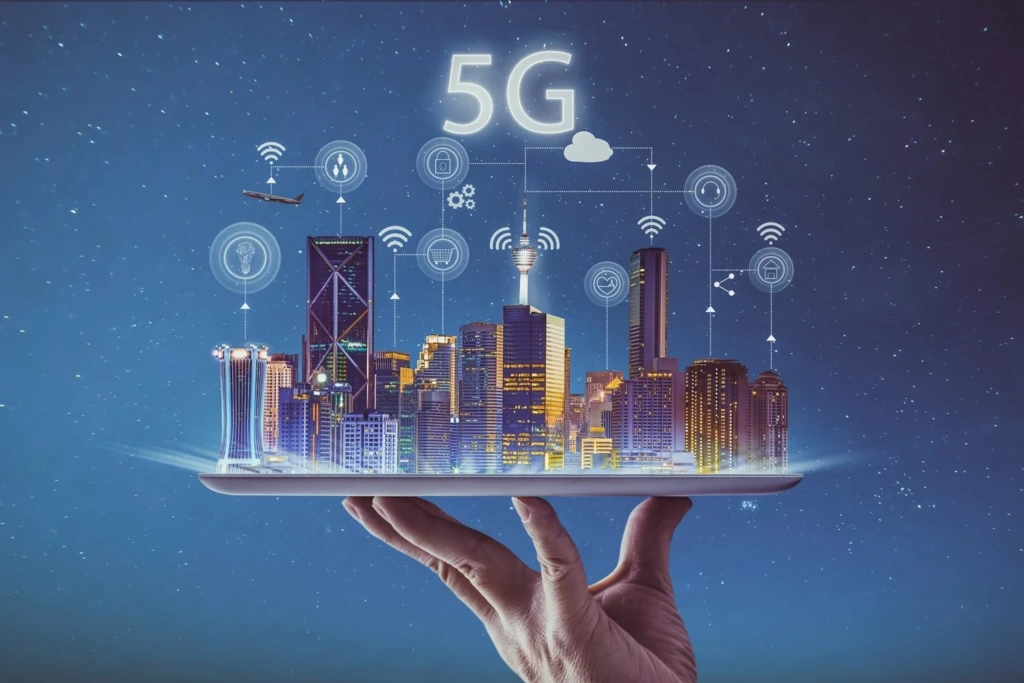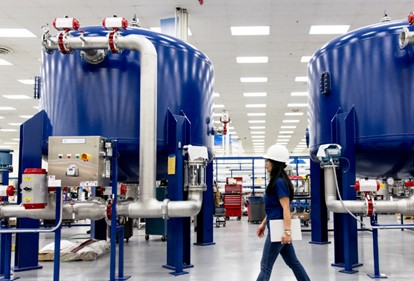
Top use cases for IoT-enabled by 5G
5G opens the doors for new enterprise IoT cases. The fifth-generation cellular standard offers increased security, support for large numbers of connected, low-power devices, and both low-latency and higher-speed performance. However, building an end-to-end IoT solution with cellular connectivity is complex. It requires expertise in embedded systems, connectivity, real-time, time series-based systems, antenna design, cloud computing, and more. As a business decision-maker, how can you simplify your project? To address this challenge, we see telecom operators offering market-ready IoT platforms to capitalize on new service opportunities enabled by 5G.

Microsoft is enabling telecom operators to rapidly develop, deploy, and monetize cross-industry edge, IoT, and other services with offerings like IoT Plug and Play, a technology that enables automated device configuration, and Microsoft Azure IoT Central, a hosted managed app platform. For critical-business applications that require low-latency, Microsoft offers Microsoft Azure Edge Zones and Azure Stack Edge. Finally, for connecting brownfield equipment operators can leverage Azure IoT Edge or Azure Sphere guardian modules.
Let’s step through top IoT use cases and see how telecom operators are helping solution builders get to market faster.
Learn how Microsoft is enabling telecom operators to deliver IoT solutions with 5G.
Case 1: Asset tracking
Asset tracking with IoT is not new but using 5G for connectivity delivers unique benefits. Below is a short list of use cases, based on the general principle that an asset tracking solution sends small amounts of data periodically from a sensor to the cloud to be stored, analyzed, and acted upon to optimize the use of assets:
- Monitoring a water or gas meter to determine usage
- Tracking the status of a city streetlight or a parking space
- Tracking the temperature and location of a box of bananas as it travels around the world

The benefits of using 5G
5G offers many benefits for asset tracking:
- Forward compatibility: 4G LTE networks available today are forward compatible with 5G. For example, CAT-M1 and NB-IoT—known as Low Power Wide Area networks (LPWAN) are the forerunners to 5G Massive Machine-Type Communications (mMTC). Some 4G LTE hardware can be enabled for 5G capabilities with a firmware upgrade.
- Low-power, low-cost sensors: LPWA sensors have long battery lives and are available at low costs making business models work.
- Better coverage: 4G LTE Technologies like CAT-M1 and NB-IoT have better wireless coverage inside buildings, underground, and in rural areas. They can transmit data to more devices in a condensed area than other cellular technologies.
Ensuring safety and compliance of pharmaceuticals and food products
Cognizant designed a pre-configured, customizable cold chain and asset tracking application, to speed up access to valuable sensor data for timely decision making. They envisioned providing operations, logistics, and supply chain managers with a near real-time view to track perishable and temperature-sensitive goods such as medicines, food and beverages, and agro products. The goal is to track these assets as they move from factory (or field) to storefront, maintain logs, and alert temperature variations to ensure safety and compliance.
Cognizant understands the complexity of building an end-to-end IoT solution using LTE and 5G technology and Azure’s reusable platform components. To simplify the project, they selected an IoT platform: the Verizon ThingSpace IoT platform with Verizon Critical Asset Sensor (CAS) devices that seamlessly integrate with Microsoft Azure’s IoT Central. This choice enabled them to get to market at a record pace as compared to building the solution from scratch.
Cognizant started with Verizon CAS sensors. These Cat-M1, low-cost, long-life sensors were perfect for measuring temperatures within boxes or pallets and reporting location data. The sensors automatically connect directly to the Azure Cloud through Verizon 5G/LTE networks, simplifying configuration and avoiding the need for an external in-vehicle or in-vessel gateways. Cognizant used an Azure IoT Central pre-built application template to develop their cold chain management solution, including analytics and dashboards. For the end-user experience, the built-in visualization features and reporting functions, as well as standard APIs for security protection.
As 5G infrastructure comes online, the 4G/LTE sensors and hardware can be updated via firmware to take advantage of the latest network capabilities. As Verizon launches an upgraded version of sensors, from CAS to GAT (global asset tracker) with worldwide cellular coverage, Wi-Fi, and Bluetooth support, Cognizant is working on advancing the development of its solution accelerator with inclusion of more personas, reports, and enterprise integrations.
Case 2: Business-critical applications
5G offers ultra-reliable low latency that enables precision business-critical use cases where safety is top priority. Low latency networks are ideal for command and control of automated guided vehicles (AGV) in a warehouse, real-time communication between robots in a smart factory, and live video with artificial intelligence for quality control.

The benefits of using 5G
5G connectivity is the best choice in this use case because, when combined with an Azure cloud connection, it offers more bandwidth, more stability, and very low latency compared to Wi-Fi options.
Reducing fulfillment warehouse space needs
A Canadian manufacturer of robotic supply chain solutions worked with a Canadian wireless network operator to build a 3D robotics fulfillment solution using a private cellular network optimized for low latency. The solution uses Microsoft’s edge computing—Azure Stack Edge—along with Azure Edge Zones to create the IoT solution on a private LTE network.
The company’s unique fulfillment automation technology condenses rows and aisles of warehouse shelves into single, vertical storage structures. Fleets of robotic shuttles move horizontally and vertically along the X, Y, and Z axes within these structures, retrieving goods and delivering them to the perimeter, where workers pick, pack, and ship them. The company asserts that its modular all-in-one supply chain product can reduce a retailer’s required warehouse space needs by 85 percent.
Case 3: Connecting brownfield equipment
The third IoT use case is directly connecting an asset to the cloud with 5G. Enterprises can turn assets in restaurants, cafes, and buildings into smart devices to improve operations reliably and easily.
The benefits of using 5G
By starting with 4G LTE and then moving to 5G, organizations in over 200 countries and territories can now connect their various devices directly to their own cloud network to securely manage and monitor them remotely. Selecting a direct cellular connection to the cloud bypasses the need for Wi-Fi and enables device connection in remote areas without Wi-Fi access. Finally, this approach enables mobile devices to roam without the need to disconnect and re-pair to multiple Wi-Fi networks.

Predictive maintenance for coffeehouse assets
A large chain of coffeehouses implemented a predictive maintenance solution for its coffee machines, grinders, and blenders using IoT. Each store had more than a dozen pieces of equipment that needed to be operational 16 hours each day.
To reduce disruptions due to equipment downtime and to securely connect its devices in the cloud, the coffeehouse chain deployed an AT&T integrated IoT solution. An Azure Sphere guardian module was attached to each asset. From there data traveled through Azure Sphere via a cellular connection to Azure.
The solution securely aggregates data and proactively identifies problems with the machines. The overarching goal with Azure Sphere is to shift from reactive maintenance to a predictive approach that heads off issues proactively.
Wrap up
5G opens the doors for new enterprise IoT use cases. We are seeing telecom operators capitalize on new service opportunities enabled by 5G with market-ready IoT platforms. These platforms reduce the complexity of 5G for solution builders.
Learn how Microsoft is enabling telecom operators to deliver IoT solutions with 5G.
Learn more about Intelligent Telecommunications to see how Microsoft and our extensive ecosystem of industry-leading partners have enabled transformational business outcomes for the likes of Vodafone, Telstra, du, Telia, and Deutsche Telekom.




